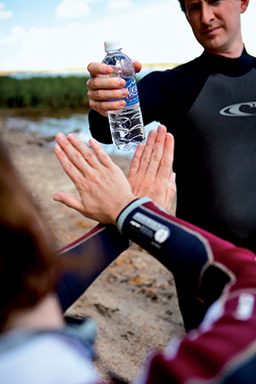The Diver
A 50-year-old female advanced open-water diver with a three-year history of breast cancer performed a series of dives on air following two days of travel. The first dive was to 100 feet for 45 minutes, with a three-minute safety stop completed before surfacing. Following a one-hour surface interval, she completed a second dive to 75 feet for 50 minutes, followed by a two-hour surface interval. This was followed by a third dive to 90 feet for 50 minutes, with an incomplete safety stop and a nonemergency, quick ascent from 15 feet.
The Incident
After the third dive, the diver presented with a mottled red rash in the abdominal area, as well as numbness in her upper extremities. The liveaboard staff immediately called DAN®, who suggested they administer emergency oxygen, provide water for hydration and monitor her condition.
The diver’s symptoms showed marked improvement very quickly. Unfortunately, the initial progress was followed by deterioration in her mental status characterized by combative and uncooperative behavior that only got worse as the day wore on. This subsequently led to refusal of additional oxygen treatment and all attempts to provide her with drinking water — both of which are recommended in the prehospital care of patients suspected of having decompression sickness (DCS). At that point, the liveaboard staff once again called DAN for further consultation. DAN provided the location of the nearest appropriate and available medical and hyperbaric facility, four hours away.

During the four-hour transit, the patient did not receive oxygen or any form of hydration. Upon arrival at the chamber, the diver’s mental status continued to decline, and she complained of hyperaesthesia, or extreme sensitivity to touch. Following a detailed examination by the hyperbaric staff, the diagnosis of DCS was confirmed, and treatment was initiated.
The Complication
Execution of the hyperbaric treatment was complicated by the diver’s compromised mental status. She was unable to assist in her treatment by equalizing or following similar commands, and after 90 minutes of unsuccessful instruction, the staff decided to have the treating physician accompany the patient in the chamber. The procedural change was successful, and it prevented the need for myringotomy, a procedure where a small incision is made in the eardrum to enable equalization.
The Diagnosis
The primary diagnostic criteria for DCS are: performance of dive profiles that are capable of causing DCS (this includes dives that are within the no-decompression limits), proximity of symptom onset relative to exiting the water and type(s) of symptoms. In this case, the patient’s dives were consistent with those that could result in DCS. The onset of symptoms soon after exiting the water is suggestive of DCS, and it also suggests that symptoms may worsen or progress rapidly. The initial symptoms of a mottled red rash in the abdominal area, as well as general numbness in her upper extremities, were both indicative of the possibility of DCS.
The initial presentation indicated a case of cutaneous DCS (or “skin bends”), worsening to neurological (Type II) DCS.
Once on 100 percent oxygen in the hyperbaric chamber, the patient showed significant improvement. When her initial treatment was complete, she was conversant, more coherent and thirsty. Due to the persistence of symptoms (not uncommon in neurological DCS), she underwent subsequent treatments until her condition improved to the point where she could resume normal activity.
The Conclusion
In emergency situations, recognition of the problem and proper response are key elements to optimize outcomes. In this case, the liveaboard staff responded appropriately with the administration of oxygen. Contacting DAN was an important aspect of patient care, as it ensured effective evacuation and facilitated referral to an appropriate treatment facility.
As diving injuries often have nebulous symptoms and can be difficult to diagnose, a call to DAN can be a vital link in the care of divers in need. In addition to our medics, DAN has diving physicians on staff as well as world leaders in dive medicine ready to consult, all to ensure that the best possible care is delivered by those in the field. DAN is here for you and can serve as a resource for treating physicians and prehospital medics. When faced with questions or concerns about an injured diver, do not hesitate to call DAN.
© Alert Diver — Q4 Fall 2010